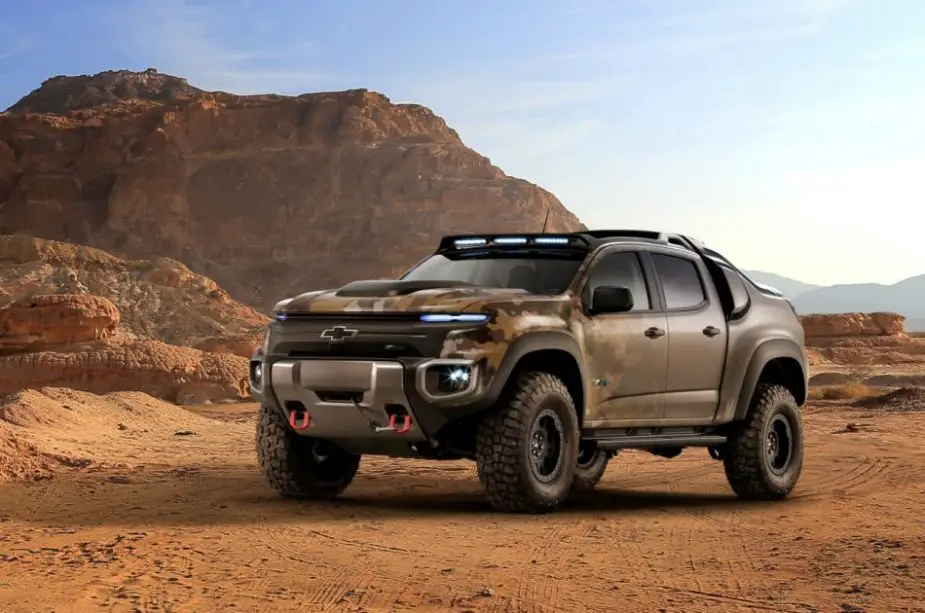Chevrolet Colorado ZH2 full-cell tested by 25th U.S. Infantry Division
The physically imposing Chevrolet Colorado ZH2, the most extreme off-road-capable fuel-cell-powered electric vehicle ever from General Motors, was revealed on October 3, 2016 at the fall meeting of the Association of the United States Army (AUSA). Its field testing has been carried on in January 2018 with the 25th Infantry Division.

Chevrolet Colorado ZH2 (Picture source: GM)
GM and the U.S. Army Tank Automotive Research, Development and Engineering Center (TARDEC) collaborated to develop the Colorado ZH2 from contract to concept in less than a year. Previous ZH2 evaluations involved Soldiers at the squad and platoon levels in real-world field conditions at Fort Bragg, North Carolina, and Fort Carson, Colorado, while the latest exercise involved an entire battalion-sized element. “The ZH2 is more than just a hybridized vehicle. It’s really a leap ahead as we look at solutions we’re trying to get on the battlefield particularly applicable to reconnaissance and security organizations,” said Lt. Col. Tim Peterman, 2nd Squadron Commander, 14th Cavalry Regiment.
Standing more than 6½ feet tall and more than seven feet wide, the Colorado ZH2 was built on a stretched midsize pickup chassis. Reinforced inside and out, the ZH2 rides on 37-inch tires and a specially modified suspension that helps the vehicle climb over and descend all manner of terrain.
The Colorado ZH2 features an Exportable Power Take-Off unit (EPTO) that allows the fuel cell to power activity away from the vehicle, such as remote locations where electric power may otherwise be unavailable. This feature is very useful, namely for telecommunications. In future military operations, having fuel cells small enough for Soldiers to carry in the field that can be used to recharge batteries used for night vision goggle systems, thermal cameras, crew systems, or any UAV assets would prove extremely useful.
The electricity that drives the ZH2 vehicle doesn’t come from storage batteries used in today’s electric cars: the ZH2 generates electricity from highly compressed hydrogen stored in the vehicle combined with oxygen from the atmosphere through an electrochemical reaction. Existing fuels such as gasoline, propane, JP8 (the Army’s main petroleum fuel source) and natural gas can also be used to produce hydrogen. TARDEC and other Department of Defense entities are researching and comparing the costs and benefits for each energy source to determine which is most effective and efficient for various areas of operation within the continental U.S. and abroad.
Paul Rogers, director of TARDEC, said that “Fuel cells have the potential to expand the capabilities of Army vehicles significantly through quiet (stealthy) operation, exportable power and solid torque performance, all advances that drove us to investigate this technology further.” The Army is evaluating the ZH2 fuel cell for Near-silent operation enabling silent watch capability, reduced acoustic and thermal signatures, high wheel torque at all speeds via electric drive, low fuel consumption across operating range, and water by-product for field uses (the two gallons of water produced per hour by the vehicle are not drinking but a purification system could be added to the vehicle).
Research work is now focused on defining how do we produce, store, transport, and distribute hydrogen on the battlefield. To make it short, what are the cost implications of hydrogen technology in various applications and phases of major combat operations?
ZH2 Fuel-cell Electric Vehicle


























